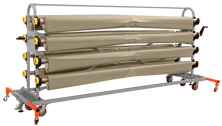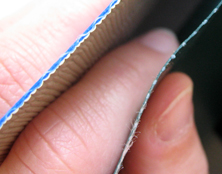
Gym Floor Cover
Encyclopedia

Tarpaulin
A tarpaulin, colloquially tarp, is a large sheet of strong, flexible, water-resistant or waterproof material, often cloth such as canvas or polyester coated with urethane, or made of plastics such as polyethylene. In some places such as Australia, and in military slang, a tarp may be known as a...
, similar to a painters tarp, usually divided into equal sections 6 to 10 ft (1.8 to 3 ) wide each to cover up the entire gym
Gym
The word γυμνάσιον was used in Ancient Greece, that mean a locality for both physical and intellectual education of young men...
floor. These covers are often used in large venues designed for athletic events when non-athletic events are being held there such as receptions, award ceremonies and graduations.
Floor damage prevention, human safety and owners wanting to multi-use their venues are the primary reasons why gym floor covers are employed. Covers are used to prevent slip and fall accidents, while protecting underlying hardwood floor from foot traffic damage and heavy furniture scratches and dents.
Tape on a maple floor
The Maple Floor Manufactures Association does not recommend the use of masking, theatrical, construction, electrical, duct, adhesive or any other kind of tape to mark temporary court boundaries on the surface of a finished maple floor. It is likely that the tape, when removed, will peel away layers of the floor’s surface finish. Most tapes promoted for temporary markings have a different coefficient of friction than finishes applied to the maple playing surface, and can impact a person’s ability to start, stop and pivot. Removing the surface paint/finish and exposing the maple can result in additional chipping and peeling of the remaining paint/finish in adjacent areas.
In addition, most commonly available tapes contain adhesive resins that can etch or stain the floor finish or even the maple flooring below the temporary markings.
The first plastic tarp gym floor cover was invented and manufactured by Covermaster Inc. in 1969 with Seattle-based Floor Guardian Inc. following up by manufacturing a recycled content, removable, portable carpet based protection system in the late 1970s to answer the demand for a product that was less of a trip hazard, environmentally sound and classier looking than what many felt was basically a painter's tarp. Since then the quality of the materials has greatly evolved. Most manufacturers have switched from vinyl and polyethylene
Polyethylene
Polyethylene or polythene is the most widely used plastic, with an annual production of approximately 80 million metric tons...
materials to more durable polyester
Polyester
Polyester is a category of polymers which contain the ester functional group in their main chain. Although there are many polyesters, the term "polyester" as a specific material most commonly refers to polyethylene terephthalate...
fabric. The best plastic tarp gym floor covers today are made of single-layer woven polyester and the newest polymer
Polymer
A polymer is a large molecule composed of repeating structural units. These subunits are typically connected by covalent chemical bonds...
materials with utilization of the knife-coating process, which enables dyes to be deposited deep into the core of the PVC
Polyvinyl chloride
Polyvinyl chloride, commonly abbreviated PVC, is a thermoplastic polymer. It is a vinyl polymer constructed of repeating vinyl groups having one hydrogen replaced by chloride. Polyvinyl chloride is the third most widely produced plastic, after polyethylene and polypropylene. PVC is widely used in...
. material and prevent peeling of the layers - a side effect of extrusion
Extrusion
Extrusion is a process used to create objects of a fixed cross-sectional profile. A material is pushed or drawn through a die of the desired cross-section...
coating or lamination process.

Modern gym floor covers are manufactured with the variety of colors, anti-slip surfaces, and weights ranging from 6 to 32 oz (170.1 to 907.2 ) per square yard (1 square yard (0.83612736 m²)). The following technical characteristics are used to describe the covers: filament size, weave count, total weight, core weight, tear strength, tensile strength, adhesion
Adhesion
Adhesion is any attraction process between dissimilar molecular species that can potentially bring them in close contact. By contrast, cohesion takes place between similar molecules....
, coefficient of friction, slip resistance, hydrostatic resistance, fire resistance and others.
Depending on if you use the tarp method or the carpet method you install it via the following steps, for the tarp method each section is installed slightly overlapping adjacent ones and secured with special adhesive tape and with the carpet method you eliminate the waste generated from the single use adhesive tape and it is installed using reusable velcro strips instead.
Installing and deploying large covers can be labour-intensive task. The most efficient way involves rolling and unrolling each section separately, and storing them on the gym floor cover storage system (rack) in a rolled up state to prevent creases and static dust accumulation. Dual cleaning brush assemblies (to remove debris) and electric power winders (to reduce manual labor during cover removal) are normally used to efficiently maintain the covers while the carpet based gym covers are best cleaned using the Chem-Dry method with the covers still in place.
Plastic tarp gym floor covers have a typical lifetime of 10–15 years and the carpet-based ones have a lifetime of 15–20+ years.

